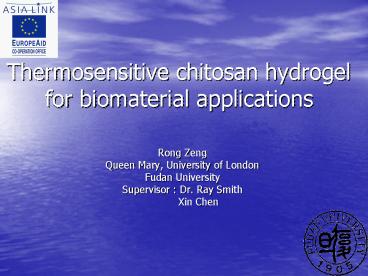Thermosensitive chitosan hydrogel for biomaterial applications - PowerPoint PPT Presentation
1 / 25
Title:
Thermosensitive chitosan hydrogel for biomaterial applications
Description:
Temperature induced gelation. Body temperature. Injectable. Topical drug delivery ... Three types of interactions may be involved in the gelation process: ... – PowerPoint PPT presentation
Number of Views:1446
Avg rating:5.0/5.0
Title: Thermosensitive chitosan hydrogel for biomaterial applications
1
Thermosensitive chitosan hydrogel for biomaterial
applications
- Rong Zeng
- Queen Mary, University of London
- Fudan University
- Supervisor Dr. Ray Smith
- Xin Chen
2
Contents
- Background
- Chitosan
- Thermosensitive hydrogel
- Experiments Some results
- GP/chitosan
- thermosensitive chitosan hydrogel
- Future work
3
Chitosan
- Structure
Biocompatibility Biodegradable Bioadhesive
4
Chitosan Hydrogel
Temporary network Safe reversible Weak
mechanical properties
Permanent network Stable good mechanical
properties Toxic
5
Thermosensitive hydrogel
- Temperature induced gelation
- Body temperature
- Injectable
- Topical drug delivery
- Tissue engineering
6
GPchitosan
- Chenite et al.(2000) developed a novel approach
to produce thermally sensitive neutral solutions
based on chitosan /ß-glycerophosphate (GP)
combinations.
7
- Three types of interactions may be involved in
the gelation process - (1) electrostatic attraction between the ammonium
groups of chitosan and the phosphate group of GP - (2) hydrogen bonding between polymer chains as a
consequence of reduced electrostatic repulsion
after neutralization of the chitosan solution
with GP - (3) chitosanchitosan hydrophobic interactions.
8
NMR test result
- 1H-NMR
- 13C-NMR
- 31P-NMR
9
1H-NMR
3,4,6 5,6
10
The line shifting is an indication of an exchange
process which is speed up by increasing the
temperature.
11
T increase
12
(No Transcript)
13
T increase
14
13C-NMR
1,4,5,3,6,2
15
(No Transcript)
16
31P-NMR
17
(No Transcript)
18
Gp/cs
19
Results
- 1H NMR data on GP/Chitosan mixture indicates that
hydrogen bonds have been disrupted as a result of
increasing temperature. If GP alone is heated,
the observed shifts are much smaller. - 13C NMR data was difficult to obtain for
chitosan solutions, still trying to investigate
the affect of temperature . But we expect no
major shift. - 31P data again indicate that in mixture of GP/
Chitosan the hydrogen bonds have been disrupted.
This is shown in a difference in shift value
between GP and GP/Chitosan . We are closely
examining the 31P-1H coupled data to verify this.
20
Thermosensitive chitosan hydrogel
- PKa
- Method
- 1, alkaline chitosan solution
- 2, change the PH value of the solution by using
different kind of acid solution
21
22
alkaline chitosan solution (PH9.6)
pluronic solution (PH4.4)
- .
Mixed solution (PH7.0)
23
T37-38?
24
Future work
25
- Thank you !
26
(No Transcript)

